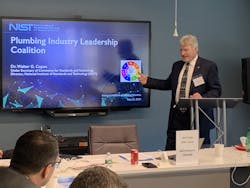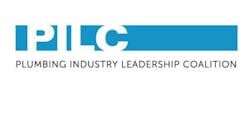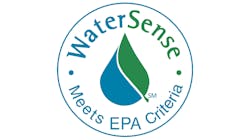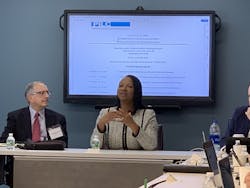PILC: WaterSense, Tariffs, Reuse and Infrastructure Take Center Stage
Each year, the Plumbing Industry Leadership Coalition (PILC) convenes to discuss legislative and regulatory issues that are top-of-mind for the industry, as well as bringing in expert speakers to shed light on those issues. This year’s May 21 meeting — hosted by the National Institute of Building Sciences and its new president, Lakisha Woods — dealt with hot-button topics such as the Trump administration’s tariffs, WaterSense funding, water and sewer infrastructure legislation, and workforce development.
Seven years ago, three co-chair organizations — the International Association of Plumbing and Mechanical Officials, the American Society of Plumbing Engineers and Plumbing Manufacturers International — created the PILC, a platform for the plumbing industry to coordinate efforts on policy issues relevant to industry players, as well as determine opportunities to collaborate on needed research and address emerging issues as they occur.
The 17 member organizations that make up PILC include: the American Backflow Association, the American Rainwater Catchment Systems Association, the American Supply Association, ASPE, the American Society of Sanitary Engineering, the Alliance for Water Efficiency, the Copper Development Association, the Cast Iron Soil Pipe Institute, IAPMO, the International Code Council, the Mechanical Contractors Association of America, NSF International, the Plumbing-Heating-Cooling Contractors-National Association, PMI, the Plastic Pipe and Fittings Association, the United Association of Plumbers and Pipefitters, and the Water Quality Association.
“PILC is intended for U.S.-based associations because there was no prior platform for them to collaborate before 2012,” explains Pete DeMarco, IAPMO’s executive vice president of advocacy and research. “In addition to plumbing-related legislative and regulatory matters, the group keeps up with industry efforts to bring safe drinking water and sanitation to people around the world through its involvement in philanthropic efforts.”
During this year’s meeting, tariffs and free trade were on everyone’s mind but PILC members had mixed opinions. “We have some member organizations that oppose the tariffs and other organizations that wish to stay neutral on the topic,” DeMarco says. “So, there may not be a clear path for PILC on this issue.”
However, the coalition did agree to draft a letter to be circulated to the PILC membership. The PILC members who do support the discontinuation of the tariffs will have the opportunity to sign on to the letter.
Anita Marie Thompkins, director of the EPA’s Drinking Water Protection Division, spoke to the group about the first significant update of the agency’s Lead and Copper Rule as well as its regulations on lead-free drinking water.
“It's the first overhaul since 1991, and we're very interested in seeing what the new proposal is going to look like,” DeMarco says. Thompkins noted that the proposed rule is due for release this December, as well as the lead-free update.
WaterSense Funding
One of the most significant issues the plumbing industry is facing right now is the continued funding for the U.S. Environmental Protection Agency’s WaterSense program, which has unanimous support from the plumbing and piping industry — manufacturers, distributors, contractors and their affiliated associations.
“We believe it's an excellent model to hold up as a well-working public-private partnership on behalf of the government that embraces environmental issues for water efficiency and provides an opportunity for manufacturers to apply a voluntary label to communicate to consumers that the product is efficient and also works well,” DeMarco says.
Over the last three years, President Donald Trump's budget submitted to Congress has called for the elimination of the program. Last year, the plumbing industry had a big victory as Congress authorized the program, which means it is no longer subject to discontinuation.
“However, what the president's budget can do is to recommend zeroing out the budget for an authorized program, so the battle going forward will be to ensure the program continues to be funded,” DeMarco explains. “That's the focus of our advocacy work as it pertains to WaterSense this year.”
He adds that the program is extremely popular in Congress on both sides of the aisle because both the manufacturing and environmental communities are behind it. “We are very confident the program will be budgeted but it does require that we continue to voice our support very clearly to Congress each year,” he says.
WaterSense funding was, indeed, eliminated from President Trump’s fiscal year 2020 budget. However, the U.S. House has voted to keep the program’s funding at 2019 levels; at press time, its recommendation had been sent to the Senate.
While the industry will be satisfied with the 2019 funding levels this year, DeMarco says PILC likely will be calling for increased funding for the program in the future so it can “look at further ways to communicate water efficiency to the public and provide opportunities for the manufacturing community.”
EPA’s Water Reuse Proposed Regs
The coalition discussed a call from the U.S. Environmental Protection Agency to submit comments on a national water reuse action plan. The agency is requesting comments by July 1 to “accelerate the application of water reuse as a safe, reliable and sustainable way to meet the country’s current and future water demands.” PILC members agreed to submit comments to the EPA from the coalition.
“I'm sure individual members will further issue their own comments on behalf of their associations but the fact that we do this under the PILC banner gives those comments additional weight and credibility,” DeMarco notes. A comment letter will be sent out to members a few weeks after the meeting for sign-on considerations.
He adds that IAPMO, working with its WE-Stand water efficiency standard stakeholders, had already drafted a separate letter precisely dealing with nomenclature and definitions within the water reuse industry, such as the interchangeable reclaimed water and recycled water.
“We have an ongoing evolution of terms that are not technically accurate; they lack technical precision as to the source of the water,” he says. “For example, terms such as rainwater are very clear as to what the source of the water is, but when you look at names such as gray water, black water and so forth, those terms lack technical precision.”
Members also voiced their concerns about how terms such as black water, brown water, yellow water, etc., have the potential to perpetuate negative stereotypes regarding people of color.
The IAPMO draft letter will be circulated to the PILC members shortly after the meeting for sign-on considerations and then submitted to the EPA.
Infrastructure, pipe sizing
PILC members are firm proponents of the upgrading of the nation’s sewer and water infrastructure. President Trump signed the America’s Water Infrastructure Act of 2018 last October; amongst other things, the law provides for improvements in public water systems and funding mechanisms. PILC is pushing for increased funding and is supportive of recent infrastructure funding discussions between the White House and Democratic leadership, DeMarco notes.
“We're facing emerging threats in the plumbing industry as it applies to the potential for water to age in the water distribution system, arrive at buildings and homes having little to no residual disinfectant,” he explains. “Our water distribution systems are porous and failing. We have a history of ‘fail and repair’ for our water distribution network that's been going on for decades. Every time a failure occurs, there's an opportunity for soil and pollutants to enter the water distribution system, which act as nutrients for opportunistic pathogens in premise plumbing systems. It's a concern to the industry.”
He says the country’s water distribution systems are grossly oversized owing to lower flow rates and consumption values associated with modern plumbing fixtures and appliances. This results in increased water age and decreased quality. PILC is working with the National Institute of Science and Technology (NIST) to address these concerns. Dr. Walter Copan, director of NIST, spoke to PILC members at the May 21 meeting about the emerging threats facing the plumbing industry.
IAPMO, in particular, has been advocating for NIST to reinstate its plumbing research lab at its campus in Gaithersburg, Md. NIST discontinued the lab back in the 1980s.
“We've been speaking directly with NIST for quite some time and requesting that they turn their attention to plumbing-related matters,” DeMarco explains. “In addition to those direct discussions, we also worked with other industry stakeholders to develop content for the ‘Moving Forward’ reports issued by the National Institute of Building Sciences to the president and Congress. We’re extremely increasingly hopeful that the plumbing lab at NIST will be reconstituted.”
IAPMO, ASPE, WQA’s Research Foundation and the University of Cincinnati collaborated in a research project to develop an updated pipe-sizing method that currently applies only to residential buildings. The research team believes the same formula will work just as well for all building types, but discrete water-use data in nonresidential structures is lacking to support that supposition.
“This effort is a great example of PILC members collaborating to conduct needed research that benefits our industry and addresses emerging concerns,” DeMarco says. “If we can successfully reduce pipe sizing in buildings, it improves water efficiency, it improves energy efficiency and it reduces water age in premise plumbing systems — all at a reduced construction cost. The risk is that without the data, we would run the risk for under-sizing plumbing systems, which carries with it a whole series of negative consequences.”
It will be necessary to meter and submeter various nonresidential building types to measure water use patterns to help implement the pipe-sizing formulas in those buildings.
On a related issue, DeMarco notes that “we have some new evidence that existing pressure drop values through water pipe fittings is incorrect and we don’t know the extent to which those values are incorrect. These inaccuracies will manifest more severely as plumbing systems are right-sized,” adding that the industry has more diverse fitting types than it had in the past.
Task force on workforce development
The skilled labor crisis in the plumbing industry — indeed, in the entire construction industry — was addressed at the PILC meeting. The U.S. Bureau of Labor Statistics projects 2026 employment for plumbers, pipefitters and steamfitters will be a 16-percent jump from 2016. Michael Copp, executive vice president of PHCC-NA, shared this statistic: for every four people who are retiring from the plumbing industry, only one replacement is coming in.
“It's a very serious issue,” DeMarco says. ”We discussed new ways to address it and we created a task force to consider retooling our message, see if it can be improved upon to attract more young people into the plumbing industry. The coalition was grateful for Lekisha Wood’s excellent insights on this topic.”
He notes that all the construction trades are battling for the same people to join their ranks, so plumbing industry stakeholders need to create better awareness of the lucrative career opportunities the industry can deliver.
“We believe as a coalition that we've done a great job on the policy end of this discussion to communicate these concerns to all levels of government,” he adds. “I think it's difficult to speak to any elected official these days without them being very aware and concerned about workforce development and the lack of skilled labor in the trades.”
About the Author

Kelly L. Faloon
Freelance Writer/Editor
Kelly L. Faloon is a contributing editor and writer to Contractor, Contracting Business magazine and HPAC Engineering and principal of Faloon Editorial Services. The former editor of Plumbing & Mechanical magazine, Faloon has more than 26 years of experience in the plumbing and heating industry and more than 35 years in B2B publishing. She started a freelance writing and editing business in 2017, where she has a varied clientele.
Faloon spent 3 1/2 years at Supply House Times before joining the Plumbing & Mechanical staff in 2001. Previously, she spent nearly 10 years at CCH/Wolters Kluwer, a publishing firm specializing in business and tax law, where she wore many hats — proofreader, writer/editor for a daily tax publication, and Internal Revenue Code editor.
A native of Michigan’s northern Lower Peninsula, Faloon is a journalism graduate of Michigan State University. You can reach her at [email protected].



